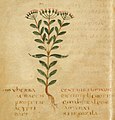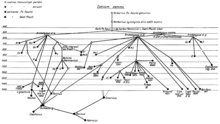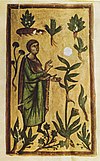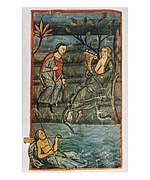Pseudo-Apuleius
Pseudo-Apuleius , Apuleius Platonicus or Apuleius Barbarus is the name of the unknown author or compiler of an illustrated herbal book ( Pseudo-Apuleius Herbarius ), the oldest surviving manuscript in Latin ( Leiden , Ms. Voss Q. 9) from the 6th or 7th centuries The original text dates back to the 4th century. He is not identical with Apuleius of Madaura, the Roman poet and philosopher of the 2nd century.
Pseudo-Apuleius Herbarius, also De herbarum virtutibus (medicaminibus)
Illustrations
... Arnoglossa . Ms. Voss. Q9. Leiden 6th century
Arnoglossa. Codex Vindob. 93 , 13th century
Drag [on] tea. Codex Vindob. 93 , 13th century
Centauria maior. Codex Vindob. 93 , 13th century
Centauria minor. Codex Vindob. 93 , 13th century
Chelidonia. Codex Vindob. 93 , 13th century
... Ni [m] fea. Codex Vindob. 93 , 13th century
....... Celidonia . ....... printed Rome 1481
From the 6th to the 15th century, the plant illustrations in Pseudo-Apuleius-Herbarius editions retained a basic characteristic that they identified as symbols of groups of plants, not as natural-study illustrations of plant species in today's sense. The contents of the Pseudo-Apuleius were included in the Parzival of Wolfram von Eschenbach with regard to the medicinal plant trachontê ("Dragon Arum ") .
Texts
Medical and art historians agree that the original text ( archetype ) of this Herbarius originated in the 4th century. According to Sigerist (1930, p. 200), Hunger, Howald and Bierbaumer and Irmgard Müller, he dined from Latin sources , according to Singer (1927, p. 37 f. And 43–47) and Felix Baumann from Greek sources. A large part of the recipes in the Pseudo-Apuleius Herbarius agree with recipes from the Naturalis historia of Pliny or the so-called Medicina Plinii . One plant each is dealt with in 128 to 131 chapters, depending on the manuscript. After the name of the plant has been mentioned, the indications are dealt with in the form of a recipe. In contrast to other herbal books, the text, which is therefore often referred to as a recipe collection, does not contain detailed descriptions of the plants. The number of recipes per chapter varies between 1 and 24. The conclusion is formed by a list of synonyms and - in the case of the β-class texts - additional additions (interpolations) from the Materia Medica of Dioscurides . Content from Pseudo-Apuleius can be found in Marcellus Empiricus .
Example: Chapter 89, Herba Millefolium (based on the edition by Howald and Sigerist 1927):
| Text after Howald / Sigerist | translation |
|---|---|
| Herba millefolium | The herb "thousand leaf" [Millefolium was later mostly interpreted as Achillea millefolium - yarrow .] |
| 1. Ad dentium dolorem. Herbae millefolium radicem ieiunus conmanducet. | 1. To toothache. The root of the herb millefolium should be chewed sober. |
| 2. Ad uulnera de ferro facta. Herba millefolium cum axungia pistata et inposita uulnera purgat et sanat. | 2. To wounds inflicted by iron. If the herb millefolium, which has been crushed with fat, is placed on it, it cleanses and heals wounds. |
| 3. Ad tumores. Herbam millefolium contusam cum butiro inpone. | 3. To tumors. Place the buttered herb millefolium on top. |
| 4. Ad urinae difficultatem. Herbae millefolium sucus cum aceto bibitur, mire sanat. | 4. On voiding disorders. The juice of the herb millefolium drunk in wine vinegar heals wonderfully. |
| Nomina herbae. A Graecis dicitur miriofillon, alii ambrosiam, alii ciliofillon, alii crisitis, Galli mulicandos, alii uigentia, Daci diodela, Itali millefolium, alii militaris, alii Achillion, alii supercilium Veneris, alii cereum siluaticum. Hanc herbam Achilles inuenit, unde ferro percussus sanabat, quae ob id Achillea uocatur ... | The names of the herb. The Greeks call it miriofillon, others ambrosia, others ciliofillon, others crisitis. The Gauls (call it) mulicandos, others vigentia. The Dacer (call it) diodela. The Italians (call it) millefolium, others militaris, others Achillion, others supercilium Veneris, others cereum silvaticum. Achilles discovered this herb because it healed wounds made by iron. It was therefore called Achillea ... |
| [Interpolationes ex Diosc.] Nascitur in palustris locis… | [ Expanding additions from the Materia Medica of Dioscurides ] It grows in swampy places ... |
Manuscripts
In the Pseudo-Apuleius Codices of the Middle Ages, the "Pseudo-Apuleius Herbarius" was combined with other works:
- "De herba vettonica". Treatise on the real betony with incorrect attribution to Antonius Musa , the personal physician of the Roman emperor Augustus .
- "De taxone liber". Anonymous treatise on the use of the badger in medicine.
- " Pseudo-Apuleius Herbarius ".
- "Liber medicinae ex animalibus", based on the Naturalis historia of Pliny .
- A version with 12 chapters on quadrupeds.
- B version with 31 chapters on quadrupeds, birds, reptiles, spiders, insects and humans.
- "(Pseudo-) Dioscorides de herbis femininis". Originated in southern Europe before the 6th century, according to Riddle.
- “Precatio terrae matris” and “Precatio omnium herbarum”. Invocation of the earth mother and invocation of all herbs.
Due to the changing composition of the codices from these individual works, Howald and Sigerist (1927, pp. V-XVI) divided the codices into 3 classes (α, β and γ). After that
- the α- class contains the parts 1, 2, 3, 4a and 5. - Also longer and better synonyms than in the texts of the β-class.
- The α-class is considered to be the class with the best text transmission;
- the β class contains parts 1, 2, 3, 4b, 5 and 6. - In addition , additional additions in the text (interpolations) .
- The β class is considered to be the class with the richest illustration. In terms of text, it is inferior to the α class;
- the γ class contains parts 1, 2 and 6.
- The γ class contains the oldest manuscripts.
According to Howald / Sigerist, the codices of the β class and the γ class come from the same original text ( archetype ). On the basis of the illustrations, Grape-Albers (1977, pp. 164–166) pointed out that the codices of all classes (α, β and γ) must be derived from the same archetype.
| class | Abbreviation (Howald / Sigerist) | Name of the code | century |
|---|---|---|---|
| α | Approx | Montecassino, Archivo de la Badia, Codex Casinensis 97 | 09th century |
| α | M. | Munich, Bavarian State Library, Fragmenta Emeranensia, Clm 14672, 14766 and 15028, a total of 8 sheets. | 07th century |
| α | L. | Lucca, Bibliotheka Governativa, MS. 236 | 09th century |
| α | Hal | Halberstadt, Domschatz (library of the cathedral grammar school), inv. No. 465-466 fols. Ir-IIv, Palimpsest (upper writing). | 07th century |
| α | Be | Berlin, State Library Fragmentum Berolinense Ms. Lat. fol. 381 no.1 | 08th century |
| α | Ha | London, British Museum, MS Harley 4986 | 12th century |
| α | V | Vienna, Codex Vindobonensis 187 (after Grape-Albers 1977, p. 3: Eton College MS. 204) | 12th century |
| α | A. | London, British Library, MS Cotton Vitellius C. iii | 11th century |
| β | Hil | Hildesheim, Beverin Library, MS. 658 | 08th century |
| β | Vr | Breslau (Wrocław) , Codex Vratislaviensis Bibl. Univ. III F 19 | 09th century |
| β | Bodley 130 | Oxford, Bodleian Library, MS. Bodley 130 | 11th century |
| β | Hey | Herten, Codicis medici Hertensis, burned | 09th century |
| β | B. | Bamberg, Codex Bambergensis med 8 (L III.15) | 13th century |
| β | Laur. 7341 | Florence, Bibliotheca Laurenziana, MS. 73.41 | 09th century |
| β | Va | Vatican, Codex Vaticanus Barberinus 160 | 11th century |
| β | Vat. Lat. 6337 | Codex Vaticanus lat. 6337 | 15th century |
| β | Laur. 7316 | Florence, Bibliotheca Laurenziana, MS. 73.16 | 13th century |
| β | Vi | Vienna, Austrian National Library, Codex Vindobonensis 93 | 13th century |
| β | Arsenal 1031 | Paris, Bibliothèque de l'Arsenal, Codex 1031 | 15th century |
| β | Paris 6862 | Paris, Bibliothèque Nationale, MS. lat. 6862 | 10th century |
| β | Ber | Codex Berolinensis Hamil. 307 | 15th century |
| γ | E. | Fragmentum Epporigiense | 07th century |
| γ | Vo | Leiden, University Library, MS. Voss. Q. 9 | 06th century |
| γ | C. | Kassel, State Library, 2 ° MS. phys. et hist. nat. 10 | 09th century |
Singer (1927), Grape-Albers (1977, pp. 2–5) and Collins (2000) mentioned further manuscripts (selection):
- St. Gallen, Abbey Library, Cod. 217, 9th century (called Botanicus )
- London, British Museum, MS. Harley 585, 11th - 12th century
- London, British Museum, MS. Harley 1585, 12th century
- London, British Museum, MS. Harley 5294, 12th century
- London, British Museum, MS. Harley 6258 B, 12th century
- London, British Museum, MS. Sloane 1975, 12th century
- Oxford, Bodleian Library, MS. Ashmole 1431, 11th century
- Oxford, Bodleian Library, MS. Ashmole 1462, 12th century
- Turin, Bibliotheca Universitaria, MS. K IV 3, 11th century, burned
Early translations
The Codex Cotton Vitellius C III (around 1050), an early Old English translation of the herbarium, is considered to be one of the earliest national-language manuscripts of the Middle Ages in Europe. A 12th century illustrated Latin manuscript from England ( Ms. Bodley 130 ) is possibly a back translation from Old English.
Invocation texts
Invocation texts of ancient pagan origin have been inserted into some texts of the β-class and the γ-class:
- a "Precatio terrae matris" ("Invocation of the maternal earth") or the "Dea sancta Tellus ". Christian zealots in the Vienna edition of the 13th century scratched off parts of the text of the "Precatio terrae matris" and rewritten them. So "Dea sancta Tellus ..." became new: "Deo sancto ..."
- a "Precatio omnium herbarum" ("invocation of all herbs").
Invocation texts are contained in the following Codices of
- γ class:
- Suffer. University library. MS. Voss. Q. 9 (6th century)
- β class:
- Breslau, Codex Vratislaviensis Bibl. Univ. III F 19 (9th century)
- London. British Museum, MS. Harley 1585 (third quarter of the 12th century)
- Florence. Bibliotheca Laurenziana, MS. Plut. 73.16 (13th century)
- Vienna. Austrian National Library, Cod. 93 (13th century)
- New Haven. Yale Medical Library. MS. 18 (first third of the 15th century)
| London MS. Harley 1585 | Florence MS. Plut. 73.16 | Vienna Nat. Bib. Cod. 93 | New Haven MS. 18th | |
|---|---|---|---|---|
| Invocation of all herbs. Illustration | ||||
| Invocation of all herbs. text | ||||
| Orant, earth mother and water god. Illustration | ||||
| Invocation of the Earth Mother. text |
Incunabula and early prints
In 1481 (until 1483), at the instigation of Johannes Philippus de Lignamine, a first print of the Pseudo-Apuleius (complex) was published in Rome based on a manuscript of the Montecassino monastery from the 9th century. This print is the first illustrated herbal book - incunabulum . Gabriel Humelberg got the first print in Northern Europe in Zurich in 1537.
Text output
- Oswald Cockayne: Leechdoms, wordcunning and starcraft of early England (Being a Collection of Documents, for the Most Part Never Before Printed Illustrating the History of Science in this Country Before the Norman Conquest). 3 volumes. London 1864–1866, here: Volume 1, London 1864 (= Rerum britannicarum medii aevi scriptores, Rolls Series, XXV. Volume 1. London, digital copy ); Reprint Vadzu 1964. - British Library, MS Cotton Vitellius C. iii (11th century) as the main manuscript.
- Ernst Howald and Henry E. Sigerist : Antonii Musae De herba vettonica, Liber Pseudo-Apulei herbarius, Anonymi De taxone liber, Sexti Placiti Liber medicinae ex animalibus. , Teubner, Leipzig 1927 (= Corpus medicorum latinorum , Vol. IV)
- FWT Hunger : The Herbal of Pseudo-Apuleius. From the ninth-century manuscript in the abbey of Monte Cassino (Codex Casinensis 97) together with the first printed edition of Joh. Philippus de Lignamine (Edition princeps Romae 1481) both in facsimile, described and annotated. Brill, Leyden 1935.
- Kai Brodersen : Apuleius, Heilkräuterbuch / Herbarius , Latin and German. Marix, Wiesbaden 2015. ISBN 978-3-7374-0999-5 .
- Hugo Berberich: The Herbarium Apuleii based on an early Middle English version. Heidelberg (1901) 1902 (= English Research. Volume 5); Reprint Amsterdam 1966, p. 65 ff.
- Erminio Caprotti, William T. Stearn : Herbarium Apulei 1481, Erbolario volgare 1522. 2 volumes. Milan 1979 (= Libri rari. Collezione di ristampe con nuove apparati. Volume 3).
literature
- Christina Becela-Deller: Ruta graveolens L. A medicinal plant in terms of art and cultural history. (Mathematical and natural scientific dissertation Würzburg 1994) Königshausen & Neumann, Würzburg 1998 (= Würzburg medical-historical research. Volume 65). ISBN 3-8260-1667-X , pp. 154–160 ( Pseudo-Apuleius, 'Herbarium' (or 'Herbarium' Apulei Platonici) ) and 180 ( types of representation of the Pseudo-Apuleius manuscripts ) and 235 (Scribonius Largus as direct Source) and 243.
- Minta Collins: Medieval Herbals. The Illustrative Traditions . The British Library, London 2000. pp. 165-220.
- Heide Grape-Albers : Late Antique Pictures from the World of the Doctor. Illuminated medical manuscripts from late antiquity and their medieval tradition . Pressler, Wiesbaden 1977, ISBN 3-87646-037-9 (also philosophical dissertation Vienna 1973: The late antique illustrations for the medical writings of Pseudo-Apuleius and Sextus Placitus and their medieval tradition ).
- Paul Diepgen : On the tradition of Pseudoapuleius . In: Janus Vol. 29 (1925), pp. 55-70.
- Günther Goldschmidt: A pseudo-Apuleius fragment in a Zurich manuscript. In: Gesnerus 1 (1943) issue 2, pp. 59-63
- Irmgard Müller: Pseudo-Apuleius. In: Lexikon des Mittelalters , Vol. VII, Sp. 306. Stuttgart 1999.
- Henry E. Sigerist : To Herbarius Pseudo-Apuleius. In: Sudhoff's archive . Vol. 23, 1930, pp. 197-204.
- Charles Singer : The Herbal in the Antiquity. In: The journal of hellenic studies. Vol. XLVII (1927) pp. 1-52, here: pp. 37-48.
- Karl Sudhoff : Scenes from the consultation and when the doctor visits the sick in medieval manuscripts. In: Sudhoffs Archiv , Vol. 10 (1916), pp. 71-90.
- Georg Swarzenski : Medieval copies of an ancient medical illuminated manuscript. In: Yearbook of the Imperial German Archaeological Institute. Vol. XVII (1902), pp. 45-53.
Web links
Footnotes
- ↑ Dracunculus or Arum species such as common dragonwort and snake knotweed come into question . See Bernhard Dietrich Haage: Prolegomena zu Anfortas' suffering in Wolframs von Eschenbach's' Parzival '. In: Würzburg medical history reports. Volume 3, 1985, pp. 101-126, here: pp. 115-117.
- ^ Bernhard D. Haage: On "Mars or Jupiter" (789.5) in the 'Parzival' Wolframs von Eschenbach. In: Specialized prose research - Crossing borders. Volume 8/9, 2012/13, pp. 189–205, here: p. 191 f.
- ↑ Arthur Groos: Wolfram's snake list ('Parzival' 481) and Pseudo-Apuleius. In: Josef Domes et al. (Ed.): Light of nature. Medicine in specialist literature and poetry. Festschrift for Gundolf Keil on the occasion of his 60th birthday (= Göppingen work on German studies. Volume 585). Kümmerle, Göppingen 1994, ISBN 3-87452-829-4 , pp. 129-148.
- ↑ Howald / Sigerist (1927), p. 48.
- ↑ Peter Bierbaumer: The botanical vocabulary of Old English. 3 volumes. Volume 2. Frankfurt am Main 1976, SX
- ↑ Felix Andreas Baumann: The Erbario Carrarese and the pictorial tradition of the Tractatus de herbis. A contribution to the history of the representation of plants in the transition from the late Middle Ages to the early Renaissance. Bern 1974 (= Berner Schriften zur Kunst. Volume 12), p. 15.
- ↑ Kai Brodersen. Apuleius, Heilkräuterbuch / Herbarius , Latin and German. Marix, Wiesbaden 2015, p. 111: Concordance to Pliny 'Naturalis Historia.
- ↑ Christina Becela-Deller: Ruta graveolens L. A medicinal plant in terms of art and cultural history. 1998, p. 155.
- ↑ Pressure: Sexti Placiti Papyriensis, de medicamentis ex animalibus, libellus. Johann Petri, Nuremberg 1538. (digitized version )
- ↑ HF Kästner (Ed.): Pseudo-Dioscorides de herbis femininis. In: Hermes. Journal of Classical Philology. Volume 31, 1896, pp. 578–636 (digitized version )
- ↑ JM Riddle: "Dioscorides". In: FQ Cranz, PO Kristeller (Ed.): Catalogus translationum et commentatorium, 4: Medieval and Renaissance Latin translations and commentaries. Washington DC 1980, pp. 125-126.
- ↑ In English translation from the manuscript Harley 1585 (London, British Museum, 12th century) in: Singer 1927, p. 48.
- ↑ Also: Georg Swarzenski : Medieval copies of an ancient medical illuminated manuscript. In: Yearbook of the Imperial German Archaeological Institute. Vol. XVII (1902), pp. 45-53. (Digitized version)
- ↑ FWT hunger. The Herbal of Pseudo-Apuleius. From the ninth-century manuscript in the abbey of Monte Cassino (Codex Casinensis 97) together with the first printed edition of Joh. Philippus de Lignamine (Edition princeps Romae 1481) both in facsimile, described and annotated. Brill, Leyden 1935.
- ↑ Leonhard v. Spengel (1803-1880). Codex Monac. Emer. E XLIII. In: Philologus. Vol. 21, (Göttingen) 1864, pp. 119 ff.
- ↑ Karl Sudhoff : The Fragmenta Emmeranensia of Pseudo-Apuleius in Munich and the Leiden Collective Codex Cod. Voss. lat. Q. 9. In: Sudhoff's archive . Vol. 8, 1915, pp. 446-450.
- ↑ Augustus Mancini. Pseudo Apulei Libellum de medicaminibus herbarum ex codice Lucensi 296 [236], descripsit, prolegomenis auxit Augustus Mancini. In: Atti della Reale Accademia Lucchese di Science, Lettere ed Arti. Vol. XXII (1904), pp. 251-301.
- ↑ Harley MS 4986 (digitized version)
- ↑ Rainer Reiche. German plant glosses from Codex Vindobonensis 187 and Codex Stuttgart HB XI 46. In: Sudhoffs archive . Vol. 57 (1973), No. 1, pp. 1-14.
- ↑ Oswald Cockayne. Leechdoms Wortcunning, and Starcraft of Early England… 1864. Therein London, British Library, MS Cotton Vitellius C. iii (11th century) as the main manuscript. (Digitized version)
- ^ Paul Lehmann. Apuleius fragments . In: Hermes , Vol. 49 (1914), pp. 612-620, here. P. 616.
- ^ RT Gunther. The herbal of Apuleius Barbarus, from the 12th century manuscript formerly in the abbey of Bury St. Edmunds (Oxford, MS. Bodl. 130) . The Roxburgh Club, Oxford 1925.
- ↑ MS Bodley 130 (digitized version)
- ^ Karl Sudhoff . Codex medicus Hertensis (No. 192). Manuscript study. In: Sudhoffs Archiv , Vol. X (1917), H. 6, pp. 265-313.
- ↑ Hans Zotter. Commentary on the facsimile edition of the Codex Vindobonensis 93. Akad. Dr.- und Verl.-Anstalt, Graz 1996. ISBN 3-201-01659-4
- ↑ 2 ° Ms. phys. Et hist. Nat. 10, Kassel. (Digitized version)
- ↑ E. Landgraf. An early medieval botany . Diss. Med. Leipzig. In: Kyklos. Yearbook of the Institute for the History of Medicine at the University of Leipzig , Vol. 1 (1928), pp. 1–35.
- ↑ Monica Niederer. The St. Gallen Botanicus. An early medieval herbarium. Critical edition, translation and commentary. P. Lang, Bern 2005.
- ↑ MS Harley 585 (digitized version)
- ↑ MS Harley 1585 (digitized version)
- ↑ MS Harley 5294 (digitized version)
- ↑ MS Harley 6258 B (digitized version)
- ↑ MS. Sloane 1975 (digitized version)
- ↑ MS Ashmole 1431 (digitized version)
- ↑ MS Ashmole 1462 (digitized version)
- ↑ Oswald Cockayne: Leechdoms, wortcunning and starcraft of early England. Volume 1. London 1864 (= Rerum britannicarum medii aevi scriptures, Rollo Series, XXV. Volume 1); Reprint Vaduz 1965.
- ↑ Linda E [hrsam] Voigts: Anglo-Saxon plans remedies and the Anglo-Saxons. In: ISIS. Volume 70, 1979, pp. 250-268, here: p. 251.
- ^ Robert T. Gunther: The Herbal of Apuleius Barbarus (MS. Bodley 130). Oxford 1925.
- ↑ Christina Becela-Deller: Ruta graveolens L. A medicinal plant in terms of art and cultural history. 1998, p. 156 and 158.
- ↑ L. Müller. To the scriptores rei medicae . In: Rheinisches Museum für Philologie . JD Sauerländer, Frankfurt am Main Volume 23 (1868), pp. 187–190 (digitized version )
- ↑ Emil Baehrens . Miscellanea Critica . Groningen 1878, pp. 107-113 (digitized version ) - Precatio terrae. Precatio omnium herbarum . In: Poetae Latini Minores. Teubner, Leipzig 1879-83 pp. 136-141 (digitized version )
- ↑ Alexander Riese . Anthologia Latina . Teubner, Leipzig 1894 p. xif (digitized version )
- ↑ Georg Swarzenski . Medieval copies of an ancient medical illuminated manuscript. In: Yearbook of the Imperial German Archaeological Institute. Vol. XVII (1902), pp. 45–53, here p. 51 (digitized version)
- ^ Charles Singer . The Herbal in the Antiquity. In: The journal of hellenic studies. Vol. XLVII (1927) pp. 1-52, here: pp. 37-48.
- ↑ Heide Grape-Albers . Late antique images from the world of the doctor. Illuminated medical manuscripts from late antiquity and their medieval tradition. G. Pressler, Wiesbaden 1977, pp. 146-150
- ↑ John I. McEnerney. Precatio terrae and Precatio omnium herbarum . In: Rheinisches Museum für Philologie . Cologne, Volume 126 (1983), pp. 175-187 (pdf)
- ↑ London. MS. Harley 1585 Orant London. British Museum, MS. Harley 1585 (third quarter of the 12th century)
- ↑ Cf. on this Christina Becela-Deller: Ruta graveolens L. A medicinal plant in terms of art and cultural history. 1998, p. 156.
- ↑ Franzesco Gonzaga. Herbarium Apulei Platonici. Rome 1481/82. (Digitized version)
- ↑ FWT hunger. The Herbal of Pseudo-Apuleius. From the ninth-century manuscript in the abbey of Monte Cassino (Codex Casinensis 97) together with the first printed edition of Joh. Philippus de Lignamine (Edition princeps Romae 1481) both in facsimile, described and annotated. Brill, Leyden 1935.
- ↑ Gundolf Keil : 'Gart der Gesundheit'. In: The German literature of the Middle Ages. Author's Lexicon , 2nd edition, Volume 2, Berlin / New York 1980, ISBN 3-11-007699-3 , Sp. 1072-1092; here: col. 1073.
- ↑ Pseudo-Apuleius-Druck Gabriel Humelberg 1537 (digitized version)
- ↑ Howald - Sigerist 1927 (digitized version)
- ↑ Goldschmidt 1943 (digitized version)
- ↑ Swarzenski 1902 (digitized version)
| personal data | |
|---|---|
| SURNAME | Pseudo-Apuleius |
| ALTERNATIVE NAMES | Apuleius Platonicus; Apuleius Barbarus |
| BRIEF DESCRIPTION | late antique author |
| DATE OF BIRTH | uncertain: 4th century |
| DATE OF DEATH | uncertain: 4th century |





























